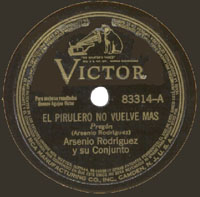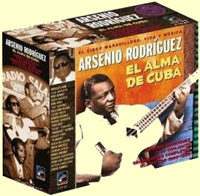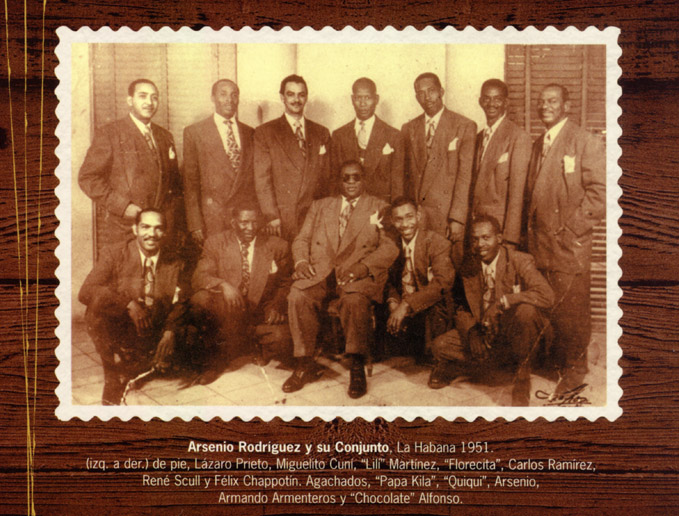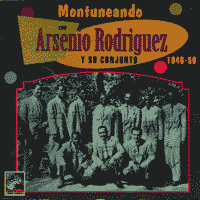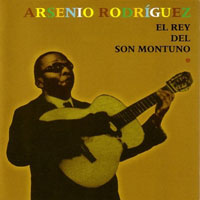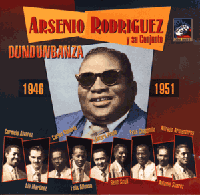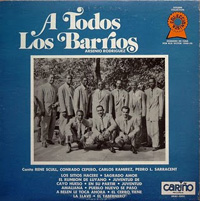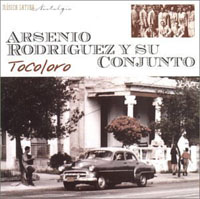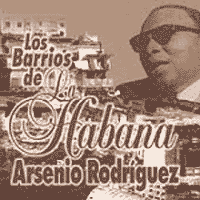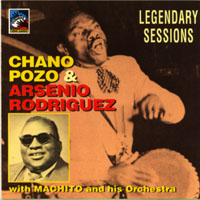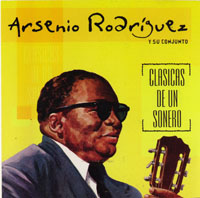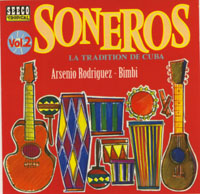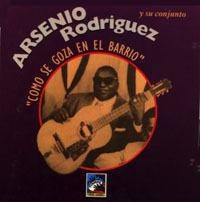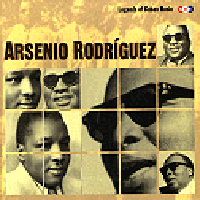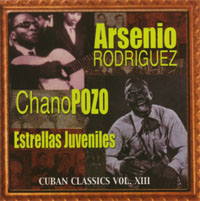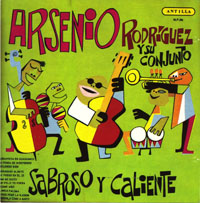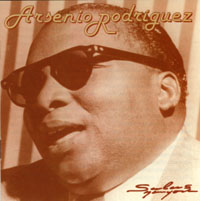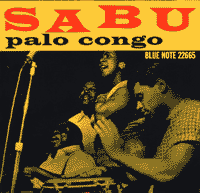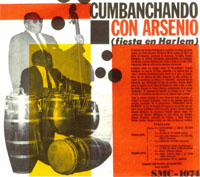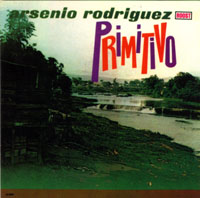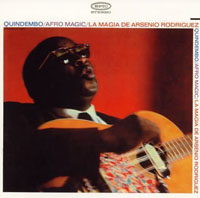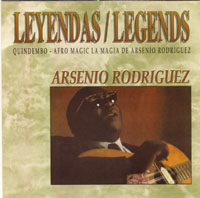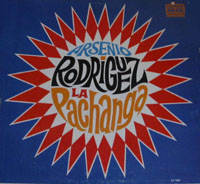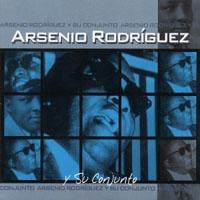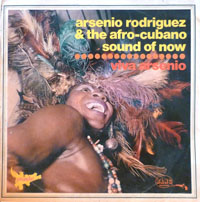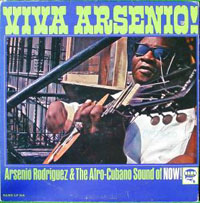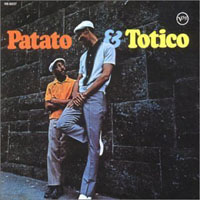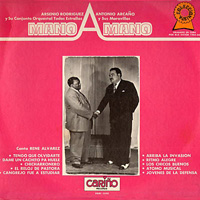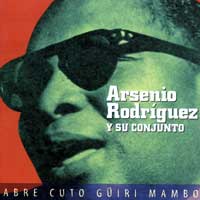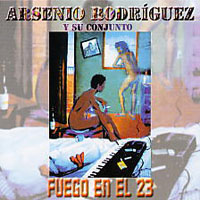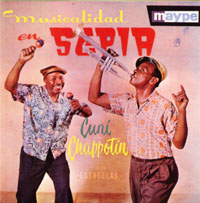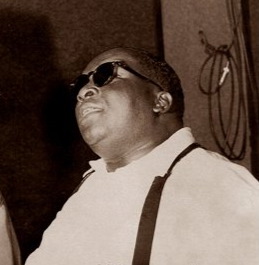
"There is no more vehement nor energetic spirit than Shàngó. When a devotee is mounted by the spirit of Shàngó, he charges three times, head leaning, spinning like a ram, towards the drums. Then he opens his eyes to abnormal width and sticks out his tongue, to symbolize a fiery belch of flames, and raises his thunder-axe on high and clamps his other hand upon his scrotum."
- Fernando Ortiz, Los Bailes y el Teatro de los Negros en el Folklore de Cuba (Havana, 1951, p. 235)Arsenio Rodríguez was born Ignacio Loyola Rodríguez Scull on 31 August 1913 in the village of Güira de Macurijes in Matanzas (Some sources say 30 August 1911 but he himself had written to the registrar to correct his birth certificate). His family was of Congolese descent, his grandfather having been brought to Cuba as a slave. He was the fourth of 17 kids in a poor family who worked the sugarcane fields. Arsenio studied traditional drumming and percussion. At age 7 he was kicked in the head by a horse which caused the loss of his eyesight. He started writing songs in 1928; in the 30s he moved to Havana to seek work as a musician. In 1937 Casino de la Playa's singer Miguelito Valdés recorded two of his songs: "Bruca manigüá," (TCD003) and "Ben acá tomá." Casino de la Playa recorded four more Arsenio compositions in 1938: "Yo son macuá," [MLN55004] "Fufuñando," [MLN55004] "Yo soy gangá," and "Se va el caramelero." [MLN55004] This last track is also collected on TCD037, and Rodríguez can be heard for the first time on record, playing tres as guest soloist. Valdés and his pianist Anselmo Sacasas moved to the USA in 1940 and were hugely influential, perhaps most notably on Desi Arnaz who modeled his style on Valdés, even adapting his trademark song "Babalu."
From his guest spot with this big band, Rodríguez had the idea of turning the typical sextet into a conjunto by adding a second trumpet and a piano. Later he added a third trumpet and a tumbadora (a big conga drum). In 1940 he made his first recordings under his own name: "El pirulero no vuelve mas," (referring back to his hit "Se va el caramelero") and "Yo 'tá enamorá." This number is described as an afro: an early example of the roots-based music Arsenio introduced to Cuban music from his deep love and study of his Congolese heritage. In 1942 he had a massive hit with "Como traiga la yuca" which the public rebaptised "Dile a Catalina" from the first line.
Arsenio moved to Miami but (not surprisingly) didn't like it; then to New York where he was more at home, and he continued to record sporadically though his groups lacked the cohesion of his conjunto in Havana. The original band broke into two with Chappotín leading one group and the rhythm section regrouping as Conjunto Modelo [TCD-059]. Arsenio was never to return home, and died in obscurity on 30 December 1970 of pneumonia, in Los Angeles, California.
There are out of print albums and many 78s not included in this list, but my aim is to help buyers avoid duplicating material in their collection, so I have focussed on CD reissues. The essential discs are the Tumbao Classics series for the Cuban material. The New York period is well served and some of the TICO reissues (those that are not plagued with bad sound) are also crucial. P-VINE in Japan does a great job of remastering many of the originals.
The CD tracks are listed according to title / style / composer / year recorded & Tumbao catalogue number for duplicates.
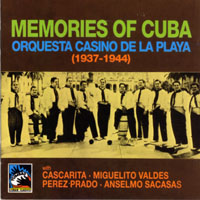
| Orquesta Casino de la Playa MEMORIES OF CUBA (1937-44)label: TUMBAO TCD 003Bruca Manigüá (AR son-pregon 1937 -- an atmospheric big-band arrangement) |
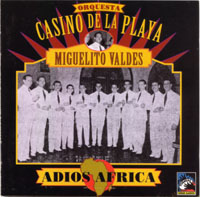 |
Orquesta Casino de la Playa con Miguelito Valdes ADIOS AFRICAlabel: TUMBAO TCD 037Adios Africa (AR son-montuno 1939?) Como le gusta el chismecito a caridad (AR son-montuno 1939?) Se va el caramelero (AR son-pregon 1938) -- Arsenio gets a namecheck for his tres solo on this track: his debut recording
Casino de la Playa canta Miguelito Valdés RUMBA RUMBEROlabel: Musica Latina Nostalgia MLN55004Sound: poor track 4: Se va el caramelero (AR 1938) track 11: Fufuñando (AR 1938) track 18: Yo son macuá (AR 1938) |
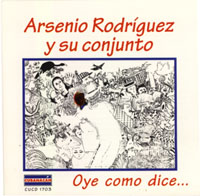 |
1940-48label: Cubanacan CUCD 1703 1997 published in Colombia, distributed in Puerto Rico |
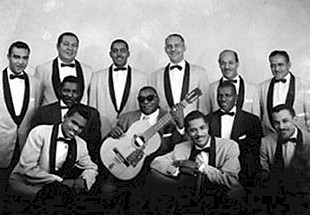 Arsenio seated in the midst of his band in the 1940s. His brother "Quiqui" sits next to him; on the front right sits Marcelino Guerra and at the front left "Kako." |
Musicians: Nilo Alfonso, bass (1942) replaced by Lázaro Prieto Israel Rodríguez "Quiqui", tumbadora (Arsenio's brother) Miguelito Cuni, vocals & maracas Pedro Luis Sarracent, vocals and clave Marcelino Guerra, coro and guitar (ex-Septeto Nacionál de Ignacio Piñeiro) Antonio Suárez "Papa Kila", bongo Ruben Calzado, first trumpet Benitin Bustillo, second trumpet Adolfito, piano (replaced by Lino Frias) Arsenio Rodríguez, musical director, tres personnel changes: Oscar Velasco "Florecita" trumpet Ruben Gonzalez, piano Lili Martinez Griñán, piano (1946) Chappotín, trumpet (1949) Jacinto Scull, vocals Alfredo Armenteros "Chocolate", trumpet (1950) |
|
1940
Among early recordings on 78 not reissued on CD or LP: |
|
EL ALMA DE CUBASound: varied; Liner notes: excellent (2 booklets in Spanish/English) |
|
1946-50 |
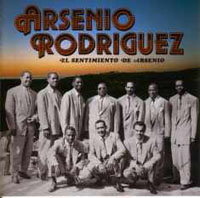 |
1946-50
(PCD1402 Japan 1990 recorded 1946-50) |
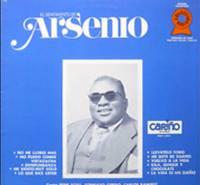 |
1946-50 |
|
also ARSENIO RODRIGUEZ EL REY DE SON MONTUNO(Rice Records UK)1. Yo 'tá namorá (on Oye como dice...) 2. Corazon de hielo (on Oye como dice...) 3. Oye como dice (on Oye como dice...) 4. El palo tiene curujey (on Oye como dice...) 5. Flor de canela (on Oye como dice...) 6. Dame un cachito pa'huele (TCD-031) 7. El Reloj de pastora (TCD-031) 8. Canta Montero (TCD-031) 9. Juventud Amaliana (TCD-031) 10. Me siento muy solo (TCD-043) 11. Tocoloro (TCD-017) 12. Apurrunenme mujeres (TCD-017) 13. la Vida es un sueño (TCD-031) 14. A Belen le toca ahora (TCD-031) 15. No me llores mas (TCD-043) 16. Pueblo Nuevo se paso (TCD-043) 17. Kila, Quique y Chocolate (TCD-031) 18. Vuelvo a la vida (TCD-043) 19. Ta benito eh (TCD-043) 20. Pobre mi Cuba (TCD-043) 21. La Gente del Bronx (TCD-022) 22. Los guapos en yatera/ la Yuca de Catilina/ El Reloj de Pastora (TCD-017) |
|
1946-51
Label: Tumbao TCD-043 1994 |
|
1946-50? (RCA 1992) also Carino DBMi-5803 |
|
1946-50
Musica Latina 55006 1999 |
|
1946-50
Orfeon Records (issued 2003); other than the opening cut, most available elsewhere |
|
1947-8
Chano Pozo & Arsenio Rodríguez with Machito & His Orchestra |
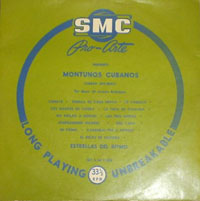
|
also tracks 13 to 16 (medley of 12 tracks) a reissue ofEstrellas del RitmoPro-Arte presente Montunos Cubanos (Cuban Off-Beat) The Music of Arsenio Rodriguez Label: SMC-508 10" (credited to "Estrellas del Ritmo" because of RCA contract) near left: green cover reissue
|

|
also Arsenio Rodriguez: Legends of Afro-Cuban MusicSMC Pro-Arte SMC-1152 (Arsenio & Chano Pozo) brown cover discoteca selecta |
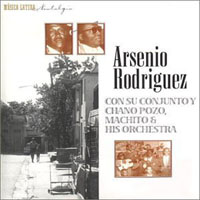 |
also ARSENIO Rodríguez con su conjunto y Chano Pozo, Machito & Orchestra(Musica Latina Nostalgia MLN 55019):all available on two Tumbao issues. 1. Serende TCD017 2. Seven Seven TCD017 3. Rumba En Swing TCD017 4. Porque Tu Sufres TCD017 5. Cometelo To' TCD017 6. Paso En Tampa TCD017 7. El Tabernero TCD043 8. Me Siento Muy Solo TCD043 9. Dundunbanza TCD043 10. No Me Llores Mas TCD043 11. Tengo Que Olvidarte TCD043 12. Pueblo Nuevo Se Paso TCD043 13. Llevatelo Todo TCD043 14. Los Sitios Hacere TCD043 15. Soy Tu Destino TCD043 16. Mi conviccion TCD043 17. Deuda TCD043 18. En Su Partir TCD017
|
|
1952
(recorded NYC, 1952 for Peer International label) |
 |
Musicians include: Arsenio Rodríguez, tres René Scull, vocals Israel Rodríguez, tumbadora Manolo, vocals Candido Antomattei, vocals Olano, vocals René Hernández, piano Mario Cora, trumpet Lázaro Prieto, bass reissued in 1958 as Exitos de Arsenio Rodríguez y su conjuntoLabel: Seeco/Tropical TRLP-5005; reissue on CD: SCCD-7352 (1998).with the addition of two tracks: Se ama una vez AR Ya voló |
|
also SONEROS vol 2: La tradicion de Cubalabel: Edenways CD EDE-1053 1997 Liner Notes: French, history of "El Son" Sound: not as good as on the preceding SEECO rerelease Tracks: 1. Se Formo El Bochinche 2. El Dolorsito De Mi China 3. Solo Fue Un sueño 4. Besarte Quisiera 5. Cambia El Paso [tracks 6-14 by Bimbi] |
|
1953
label: Tumbao TCD-022 1992 |
 |
First 8 tracks taken from AUTHENTIC CUBAN MAMBOSgreen check cover [left]Label: TICO 135 10" |
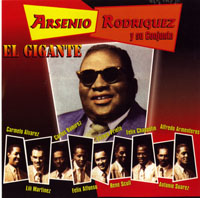 |
also EL GIGANTE(TICO TRSLP1449)
1. La Gente del Bronx Note: the two bonus tracks are performed by Ismael Miranda from Arsenio tribute albums, all others are found on TCD022. Even the cover is a rip-off of the artwork for Tumbao's DUNDUNBANZA. However, Tico was the original issuer of this album.
|
|
1946-50Arsenio Rodríguez: Legends Of Cuban Music(NC 5032), Released 2001Another compilation drawn from the four main Tumbao releases, covering many classics. El Reloj De Pastora (son montuno) TCD017 or ALP-1337 Juventud Amaliana TCD031 Dame Un Cachito Pa'huele TCD031 Canta Montero (bolero son) TCD031 Cangrejo fue a estudiar (son montuno) TCD031 Pueblo nuevo se paso TCD017 Dundumbanza TCD-043 No me llores mas TCD-043 Llevatelo todo TCD-043 Vuelvo a la Vida TCD-043 La Gente del Bronx TCD-022 Yo soy chambelon TCD-022 Arpegio por Arsenio TCD-022 Mulence TCD-022 Maye Santa TCD-022 Chicharronero TCD-031 Adivínalo (guaguancó) TCD031 El Cerro tiene la llave (guaracha) TCD031 Meta y guaguancó TCD-022 Oiga mi guaguancó TCD-022 Como se goza en el barrio TCD-022 |
|
1953 |
|
1955 |
|
1957 |
|
some duplicated onArsenio RodríguezLabel: Discmedi Records/ ARTEX Canada CD-066 1993 Notes: good notes in Spanish by Zola Gomez García Sound: Mostly good The extraneous material, particularly by Irakere, is unnecessary but helps demonstrate the breadth of Arsenio's influence. 1. Preludio a Catalina (Performed by CHUCHO VALDES) 2. Dile a Catalina (Performed by IRAKERE) 3. Buenavista en guaguancó (ANTILLA CD-586) 4. Fiesta en el solar (Primitivo) 5. Juventud Amaliana TCD031 6. Recuerda bien (ANTILLA CD-586) 7. De una manera espantosa (Performed by IRAKERE) 8. Frutas del caney (Ansonia HGCD1337) 9. Blanca paloma (ANTILLA CD-586) 10. Que feliz yo fuera (ANTILLA CD-586) 11. Besame aqui (ANTILLA CD-586) 12. Mami me gusto (ANTILLA CD-586) 13. Hachero pa' un palo (Performed by MANGARE)
also Boogaloo con los Tres GrandesLabel: LP Puchito MLP-609 (Antilla 609) Includes the orquestas of Arsenio, Chappotín & Melodias del 40. The Arsenio tracks are Carraguao alante Blanca Paloma Mami me gusto
also "Carraguao Alante" on Habana Club: A Cuban Jam Session |
|
1957 |
|
1962
SMC-1074 |
|
1963
Orig: ROOST LP2261 1963; Reissued: Blues Interactions (Japan) PCD-4729 1995; also TICO 1407 |
|
1963 |
|
1963 |
|
1966
Label: Ansonia (ALP-1337) vol 1* |
|
1966
cantan: Marcelino Guerra - Ceron - Berrios |
|
1966
Label: BANG LP 216 (1966) Canada also SONY JAPAN CD |
|
1960s
CD (Faisan 512), Reissued 1995 |
|
1968
Label: Verve V/V6-5037 |
|
1968
producer: Pancho Cristal |
|
1940s |
|
ABRE CUTO GUIRI MAMBO |
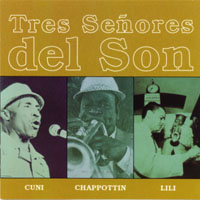
|
1940-94Further listening: "Tres señores del son Miguelito Cuni - Felix Chappotín - Luis Martinez Griñán (Lili)" EGREM Cuba 1992 Cuni con Chappotín sus estrellas "Musicalidad en sepia" Orig: Maype; CD reissue: P-Vine Japan PCD2229 1990 Chappotín y su conjunto "Coleccion de diamante vol 2" (DC Productions, France DC 9202 CD) Conjunto Modelo (canta Miguelito Cuni) "Guaguancó en la Habana" Tumbao TCD-059 (recorded in Havana 1953-4) Orquesta Sierra Maestra "Dundunbanza" (World Circuit WCD041 1994) Fabulous tribute to Arsenio album
Sources: Ortiz quote (epigraph) quoted in Robert Farris Thompson, Flash of the Spirit |

